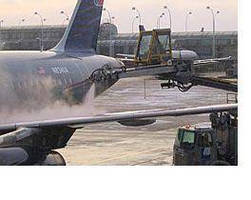Waste Water Monitoring for an Airport Group

CHESTERLAND OH - CAS DataLoggers recently provided the data logging solution for a major airport group based in the UK whose fluid run-off threatened to endanger aquatic ecosystems located near the airports. The commercial airline needed an online device capable of monitoring toxic discharges into local rivers. The airline routinely sprayed de-icers and anti-icers onto their aircraft before taking off during icy conditions as mandated by Federal Aviation Administration guidelines. Between 100 and several thousand gallons of de-icing fluid was used per aircraft application. While a portion of the fluid stuck to the planes, approximately 75% to 80% of the treatment would flow into the surrounding environment as run-off.
The bases of all de-icing fluids contain propylene and ethylene glycol, also used as antifreeze in cars. While the de-icers were decreasingly toxic, the anti-icer mixtures contained chemical additives preventing the formation of new ice. As government agencies were developing storm water run-off guidelines for the airport de-icing procedures, this group of airports were going to great lengths to monitor their toxic run-off to accommodate future regulations and lessen the environmental impact.
CAS DataLoggers Applications Analysts determined a MSP Remote Data Logger System (MSP) connected to an ultrasonic flow meter, would immediately provide the airports remote online web access to both current and historical data on discharge and flow volume. The MSP system featured analog, digital and serial sensor interfaces, a 20 channel data logger, local data storage, smart power management, batteries, a solar regulator, a GPRS modem, GSM/GPRS antenna and a global SIM card - all incorporated into a single unit. The data recorder also intelligently controlled and powered the airport sensors which supported a wide range of interfaces and protocols. Data was transmitted from onsite to the data logger manufacturer's central servers via the integrated GPRS modem. The MSP system was then interfaced with Flo-Dar flow sensors for real-time data collection. The Flo-Dar sensors combined digital doppler radar velocity sensing technology with ultrasonic pulse echo level sensing to remotely measure open channel flows.
Ruggedly-designed, the MSP system came housed in an IP65 weather-resistant enclosure, guaranteeing extreme durability. It had ultra-low power requirements, operating from an internal rechargeable lithium battery, and the unit was further supplemented by solar power. The MSP included several accessories, including a USB cable and a removable 1GB micro SD memory card.
The MSP system's many added capabilities helped staff to monitor the waste water run-off more efficiently. For ease of use, airport staff could remotely configure the logger from the manufacturer's website, viewing both live and historic sensor data. Facilities for data export existed in a variety of formats including CSV, Excel, and XML, making all the information manageable. The MSP's graphing engine offered powerful and intuitive website graphing features, moving graphs back and forward in time and zooming in and out. This allowed users to overlay multiple sensors, view statistics and work with the data more flexibly. Using real-time mapping features, sensors could be placed into popular mapping tools such as Google Maps to easily manage the airport group's large numbers of sites. Both management and maintenance were simplified through a variety of system management reports and logs.
The customer instantly benefitted from the installation of the MSP remote data logging system in several key ways. The data logger eliminated the complexity and cost of manually collecting and organizing the data from the airports' remote field based sensors, instruments and control systems. This complete solution was rapidly installed and implemented. Easy operation by personnel without relying on IT infrastructure became apparent as well. The advanced graphing and mapping features allowed the airport group to more easily and efficiently monitor the run-off from each of the airports in the client's group. Alarm conditions and recipients were maintained from a central website and personnel could distribute alarms via email, SMS text message, or web service calls. Each device alarm could be independently enabled or disabled and all alarms were stored locally as well as logged onto the central servers.
Options such as power supply plug-ins at 5V, 12V and 24V are available with this system configuration. The internal lithium battery may be chosen as an upgrade to 10Ah and 15ah for longer life. High-gain antennas can be configured for increased signal strength. Another value added upgrade for a heavy-duty solar regulator for 25W+ solar panels provides a green solution. GPS accessories are also available for easy tracking.
For further information on temperature monitoring solutions, cold chain logistics and transport applications, facilities monitoring and alarming, or data acquisition and control, contact a CAS Data Logger Applications Engineer at (800) 956-4437 or visit the CAS website at www.DataLoggerInc.com.
Contact Information:
CAS DataLoggers, Inc.
12628 Chillicothe Road
Chesterland, Ohio 44026
(440) 729-2570
(800) 956-4437
sales@dataloggerinc.com
www.DataLoggerInc.com




